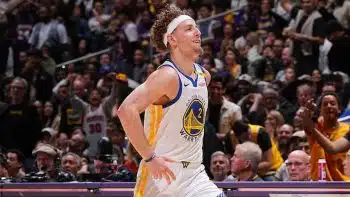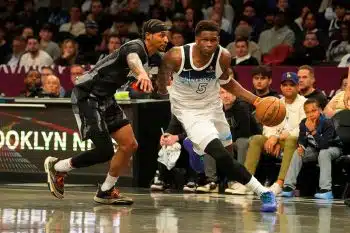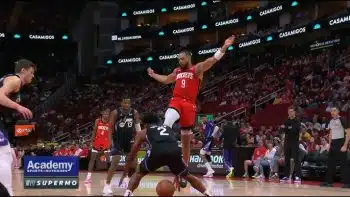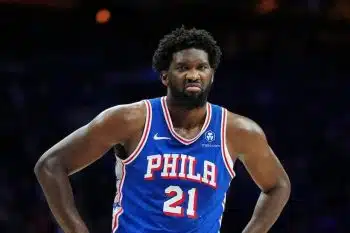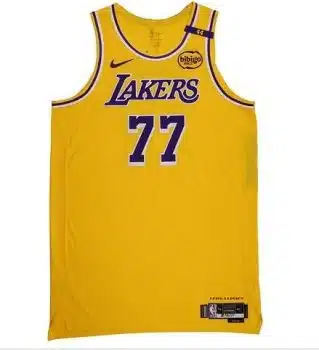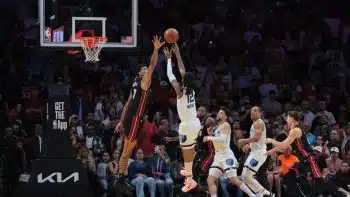NBA
Dunc’d On: Random Thoughts on Nets, Hornets
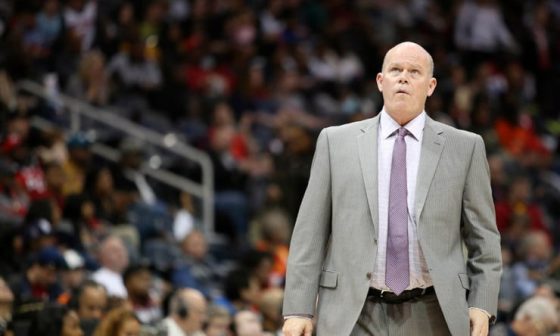
Please forgive this rather ad hoc post, but this seems as good a time as any to disgorge a few random thoughts that have been rattling around after an East Coast trip.
Brooklyn Nets
The Brooklyn Nets played the most desultory game I have seen in person this year, getting absolutely torched in a 115-91 loss by a Hornets squad that ranks 28th in the league in offense and was still missing Kemba Walker. The defensive performance was so disheartening for the Nets because they were carved up by the same play over and over again, a pick and roll on the left side of the floor. The Nets did not ice* the side pick and roll, instead letting Mo Williams repeatedly get to the middle and hit the roll man going to the basket or finding direct-line passes to shooters on the weakside. The well-known gunner racked up a crazy 14 assists in only 31 minutes. The strategy was to bring the opposite big all the way over to the baseline on the strong side to deal with the roll man, and that failed miserably. But the worst part was Brooklyn never made any visible adjustments.
Charlotte Hornets
Many, including your writer, wrote off the Hornets after a miserable start. But they are right back in the playoff hunt in the Eastern Conference. That beginning was largely blamed on the acquisition of Lance Stephenson, and to be sure he has been awful all season. But much as with their mid-season swoon a year ago, an underrated factor in the early-season malaise was the injury absence of Michael Kidd-Gilchrist. Charlotte’s bread and butter is their outstanding defense, for which MKG is the catalyst. He has gotten more attention for his poor shooting stroke and his attempts to fix it thus far in his career, but he is one of the league’s best defending the wing.
Take his exemplary effort against Brooklyn guard Joe Johnson last week, by which Kidd-Gilchrist held the power wing to 1-6 shooting in 23 minutes with zero assists. The few times Johnson went for his trademark mid-post isos, Kidd-Gilchrist snuffed them out with aplomb. Johnson is by no means a top threat at this point, although you can ask the Toronto Raptors about the damage he can inflict in the right matchup. But what a defender can do against mid-tier guys can be more telling than how he defends the elite. Star players will invariably be the focus of the offense and have the type of talent that makes them very difficult to guard for anyone in the league when they are featured. But great defenders can sometimes provide more value-added on average scorers by completely eliminating them from the offense. Kidd-Gilchrist has that type of ability.
Steve Clifford is yet another underrated factor in the Hornets’ success. The then-Bobcats’ sixth-ranked finish in defense a year ago always seemed born of smoke and mirrors with a frontcourt anchored by Al Jefferson. When Charlotte regressed badly to start the year on that end, it appeared last year’s performance may have been unsustainable, especially with the exchange of power forward Josh McRoberts for free agent signee Marvin Williams. But the return of Kidd-Gilchrist and necessary adjustments by Clifford have righted the ship. Since January 1, the Hornets’ 96.1 defensive rating (per NBA.com) leads the league. To effect this change, Clifford elevated Gerald Henderson to the starting lineup over Stephenson while Cody Zeller supplanted Williams (formerly a wing who struggles to defend the post and the basket) at the four. Charlotte’s entire organization deserves credit for the success of Stephenson’s demotion–many teams would have continued to force a prized free agent acquisition into the lineup* in an effort to validate the three-year, $27.4 million ($18 million guaranteed) contract he received in the offseason.
Despite the success of this starting lineup, Clifford did not hesitate to adjust against the small-ball Nets, who started Johnson at power forward. Rather than force Zeller to match up with a wing, Clifford went back to Williams in the starting lineup and saw his squad absolutely crush Brooklyn in the first and third quarters.
Perhaps it is fueled by stubbornness, a desire to avoid appearing unconfident, or the failure of the most salient example of changing one’s starters (Avery Johnson famously sitting Erick Dampier for Devean George in Game 1 of his 67-win squad’s series loss to Golden State in 2007), but few teams are willing to change their starting lineups based on matchups until they have accumulated evidence it is not going to work. And certainly, taking a great player off the floor to match up with the other team is terrible strategy. Zeller, however, is not one of those players. He clearly would have been at a disadvantage trying to guard a wing, and Charlotte wasn’t going to feature him in the post to make up for it on the other end. Rather than punt a few minutes at the start of each half, Clifford went with the lineup he knew was more likely to work right away and it paid off.
Trailing Teams Need to Implement Higher-Variance Strategies Earlier
Viewers generally underestimate how difficult it is to come back from down double digits in the second half of the fourth quarter. The league median for pace is about 93 possessions per game, per the actual possession counts at Nylon Calculus. That means teams get about two possessions per minute. Take a team down 12 with three minutes to go. That team basically has to be perfect on both ends the rest of the game to outscore the opponent by 12 points in six possessions. While they may manage to speed things up by fouling in the last minute, the other team is also more likely to milk the shot clock to counteract that.
This math indicates that higher-risk strategies need to be implemented when trailing by 10 or more points much earlier and more frequently than coaches usually do now. Whether that is fouling earlier (especially taking the chance to foul poor free throw shooting big men immediately upon getting a rebound), shooting as many threes as possible, or (my favored strategy) going to a full-court zone press*, trailing teams need to shake things up. While pressing has been derided and probably would not be effective over a full game, full-court zone presses have never really been tried since the league went to the eight second count. That two seconds could make a huge difference from the days when Rick Pitino tried and failed to press as the Celtics’ head coach. NBA teams do not practice zone press-breakers since they are used so infrequently, and especially during the regular season it could be an effective high-variance strategy at the end of games. A press would also have the benefit of forcing the opponent’s worst free throw shooters to handle the ball more often, allowing more effective fouling as well. At the very least, the press would likely lead to quicker shots from the opponent instead of allowing them to simply milk the clock.
Alas, we are unlikely to see these strategies implemented. Fouling and shooting exclusively threes are bad strategies over the course of a full game, and pressing likely is as well. The most likely outcome of trying them is falling even further behind, but they also give a team a better chance to win by increasing both the number of possessions and the variance of those possessions.
Psychologically though, that team down 12 with three minutes to go still feels like it’s in the game, even if its win probability is really in the low single digits by that point. And continuing to play relatively normally, whittling the lead down a bit more*, and ending up losing by six feels better than the higher-risk strategies. The team was still “in the game” until the very end. By contrast, if a team puts on the press in that situation, they could give up two easy buckets, go down 16 and then the game feels like it was a blowout. But the point of basketball is to win, not feel like you have a chance to win. Risky, high-variance strategies are still better than playing it safe trailing by double digits down the stretch.
Actual Versus Estimated Possessions
Speaking of possessions, they are calculated by adding shots, turnovers, and free throw possessions, then subtracting offensive rebounds. But NBA.com and other websites use an estimated possession calculator that ends up around three possessions per game higher. This is due to what I call odd free throws and actual offensive team rebounds. Most free throws are shot two at a time, which uses a possession. So generally the number of free throws could be divided by two to determine the number of possessions ending in free throws. Odd free throws result from all free throw attempts that are not part of two shot fouls, namely technicals, and ones and three-shot fouls. Estimated possessions multiply the number of free throws by a number designed to approximate the number of odd free throws so that the possessions even out, usually 0.44 in most formulas. But this is just an estimate and penalizes teams that get a lot of and ones or three-shot fouls.
As noted, offensive rebounds are subtracted in calculating total possessions. This makes obvious sense; if a team gets an offensive rebound the possession continues even though a shot has occurred. Actual offensive team rebounds occur when a team misses a shot and the ball goes out of bounds. Sometimes this is due to a shot block by the defense, other times due to pressure from an offensive rebounder resulting in a lost ball out of bounds, or a “stay right here” loose ball foul in favor of the offense. These are scored simply as team rebounds in the box score and play-by-play, but should result in subtracting a possession just like a regular offensive rebound when calculating pace or team per possession efficiency. Unfortunately, the NBA does not differentiate between offensive and defensive team rebounds. What’s more, it also scores team rebounds when the first of two free throws is missed, on missed heaves at the end of a quarter, or when a shot misses the rim resulting in a shot clock violation. This apparently is born of a desire to have a “rebound” credited on each missed shot attempt so everything adds up, debit and credit style. It would be nice if the league changed the scoring to better comport with modern concepts of possessions. It might even go so far as to credit offensive rebounds to players who draw loose ball fouls going for offensive rebounds or contest the rebound so it is lost out of bounds in favor of his team.
Nylon Calculus–and your writer while live-Tweeting games– use the play by play data to determine odd free throws and actual offensive team rebounds to arrive at an actual possession count. A little change in game scoring would make those numbers a lot easier to work with.
